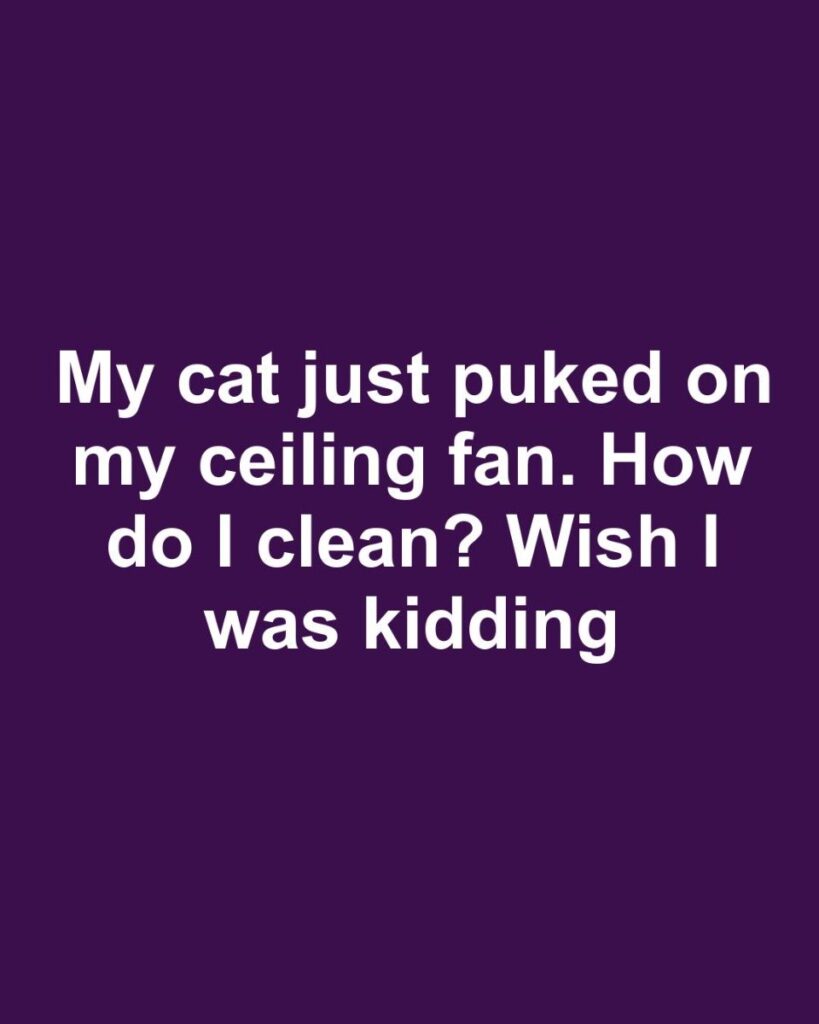Could really use some input here
Morgan Reed
Contributing Writer
Print this recipe
Cats are known for their agility and sometimes unpredictable behavior. It’s possible that your cat managed to jump onto the ceiling fan or a nearby high shelf, and in a moment of discomfort or illness, vomited. Cats can also project vomit due to the force of retching, which might explain how it ended up on the ceiling fan. Understanding your cat’s behavior and health is crucial in preventing such incidents in the future.
Immediate Steps to Take After the Incident
First, turn off the ceiling fan immediately to prevent the mess from spreading further. If the fan is on, the vomit could be flung across the room, making the cleanup process even more challenging. Once the fan is off, assess the situation and determine the extent of the mess. It’s important to act quickly to prevent stains and odors from setting in.
Gathering the Necessary Cleaning Supplies
You’ll need a few key supplies to tackle this mess effectively: rubber gloves, a step ladder or sturdy chair, paper towels or a clean cloth, a mild detergent or all-purpose cleaner, a spray bottle with water, a sponge or scrubbing brush, and a disinfectant. Having these items ready will make the cleaning process more efficient.
Safety Precautions Before Cleaning
Before you start cleaning, ensure your safety by turning off the ceiling fan at the switch and unplugging it if possible. This will prevent any accidental activation while you’re cleaning. Use a stable step ladder or chair to reach the fan safely, and wear rubber gloves to protect your hands from cleaning chemicals and the mess itself.
Step-by-Step Guide to Cleaning the Ceiling Fan
1. Carefully climb the ladder or chair to reach the ceiling fan.
2. Use paper towels or a cloth to gently remove as much of the vomit as possible. Dispose of these immediately.
3. Spray the affected area with a mild detergent or all-purpose cleaner. Allow it to sit for a few minutes to break down the residue.
4. Use a sponge or scrubbing brush to gently clean the blades and any other affected parts of the fan.
5. Rinse the area with a spray bottle filled with water and wipe it dry with a clean cloth.
6. Finish by disinfecting the area to eliminate any lingering bacteria or odors.
Dealing with Stubborn Stains and Odors
If stains or odors persist, consider using a baking soda paste (baking soda mixed with a small amount of water) to scrub the area. Baking soda is a natural deodorizer and can help lift stains. Alternatively, a vinegar and water solution can be effective for both cleaning and deodorizing. Apply the solution, let it sit for a few minutes, then wipe clean.
Preventing Future Incidents
To prevent future incidents, monitor your cat’s health and behavior. Ensure they have a balanced diet and access to fresh water. If your cat is prone to jumping onto high surfaces, consider using deterrents or providing alternative climbing options like cat trees. Regular vet check-ups can also help identify any underlying health issues.
When to Call a Professional Cleaner
If the mess is extensive or if you’re unable to clean it thoroughly, it may be wise to call a professional cleaner. This is especially true if the vomit has seeped into hard-to-reach areas or if there are persistent odors that you can’t eliminate. Professionals have the tools and expertise to handle such situations effectively.
Conclusion: Keeping Your Home Clean and Safe
Dealing with unexpected messes is part of pet ownership, but with the right approach, you can keep your home clean and safe. By understanding your cat’s behavior and taking preventive measures, you can minimize the chances of such incidents occurring again. Regular cleaning and maintenance of your home, along with prompt action when accidents happen, will ensure a healthy environment for both you and your pet.

